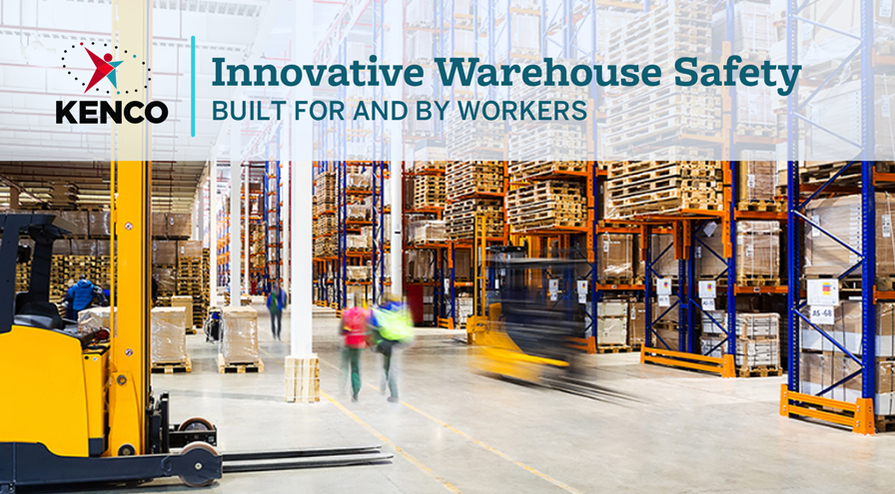Warehouse safety is often defined by the absence of something (like injuries), but its focus is beginning to shift toward the presence of defenses, resiliency, the capacity to fail, and safety innovation. In recent years, technology has helped move the needle in warehouse safety for supply chain providers, helping to evolve warehouse employee ergonomics and prevent high potential events. Their value cannot be understated. But the real driver behind the adoption of these solutions comes from associates out in the field who share their observations, concerns, and feedback to create a safer supply chain.
By leveraging these two invaluable assets—employees and technology—warehouse managers can gather data to stay a step ahead of workplace safety. In doing so, they not only prevent injuries, boost productivity, and cut costs, but also bolster employee engagement and satisfaction.
Safety innovations should be both inspired by employees and built for them. Below are examples of employee-centric solutions to supply chain warehouse safety and why they boost morale alongside physical wellbeing.
Ergonomically Tailored Warehouse Technology Built for Humans
Previously, associates were expected to adapt to their workplace. But today, the supply chain is investing in technology that helps the workplace adapt to the worker.
There are several types of wearable technologies that help prevent common injuries. Some wearable devices use AI to coach workers in real time, alerting them when they’ve made a movement that could cause an injury (i.e. improper bending and twisting) and allowing the employee to self-correct, thus resulting in long-term behavioral improvement. Facility managers can then analyze data collected from these devices and make necessary adaptations to racking and product layout for ergonomic safety.
HeroWear Exoskeletons provide another example of ergonomic innovation that adds mechanical advantage to the body. Worn on the back like a backpack with additional straps that close around the thighs, the device fits employees of all shapes and sizes to reduce over 75 pounds of strain on the back—all while weighing just over three pounds. Kenco is one of the first players to introduce this customized solution in its warehouses.
Additionally, spring-actuated pallet carousels can raise and lower the height of the surface depending on the weight of the pallet (the lighter the pallet gets, the higher it lifts) so that associates are always lifting at optimal height.
These are just a few examples of ergonomic innovation in warehouses today. By investing in such technologies, facility managers can ensure their employees go home at the end of the day in the same condition that they came in (or even better).
Protecting Warehouse Workers from High Potential Events
The above ergonomic technologies are tailored to human anatomy on a granular level to help prevent musculoskeletal strain and injury, but warehouse managers must also do everything in their power to prevent high potential events from occurring. The supply chain warehouse industry has made great strides in preventing these events, with the number of fatal incidents remaining stable despite the number of warehouse employees doubling in the last 10 years. With continual improvement and innovative safety solutions, however, we can work to drive this number to zero.
46% of forklift-related fatalities occur when a pedestrian is struck by a vehicle. Luckily, there are simple mechanical solutions to this significant issue in the industry. Kenco’s proprietary telematics solution, FleetCloud, for example, offers wearable Bluetooth-enabled IoT devices, like a bracelet, that can detect when a lift truck is close to a pedestrian, alerting the pedestrian and even disabling the lift truck if necessary to avoid a collision.
Additionally, forklift overturn is the most common fatal incident in the warehouse, and is often caused by trucks pulling away from the dock or separation of the truck and dock due to inferior dock securement. Kenco utilizes a chocking solution that actively chocks the wheels of a trailer as it arrives at a facility, preventing the trailer from pulling away while a lift truck is inside or partially inside.
Better Safety, Better Engagement, Better Data
Warehouse safety can’t simply come from corporate boardrooms; safety innovations are inspired by and built for associates in the field. Therefore, it’s critical that facility managers stay engaged with their employees and constantly leverage their expertise on ways to improve safety. The supply chain work environment is growing more complex every day, which further warrants the need for a collaborative work culture open to innovation.
By meticulously listening to employees’ ideas and interactions with new safety protocols and technologies, facility managers can gather data over time that will help inform advanced analytics to manage and predict the safety needs of the future. It will be important to engage as many employees as possible and set a culture of open communication to gather holistic data.
At the end of the day, employees in all industries want to feel seen and appreciated. When they see management making actionable steps to make their daily lives better, it spurs a massive boost in employee morale and gives the employer a competitive edge. The technologies above are just a few examples of ways that facility management can go above and beyond in ensuring the wellness of associates, but the real key lies within the workforce itself.
Visit our Kenco FleetCloud page to learn more or speak with a professional to take the first step toward a safer warehouse today.

